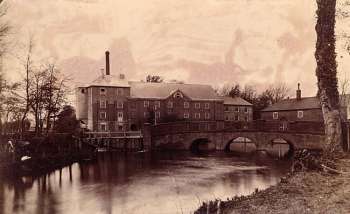
|
Fakenham Mill
River Wensum |
 |
|
c.1890
|
|
Fakenham Mill was built c.1720 on the site of an older mill dating from 1620.
A wall plaque bears the date 1885, which presumably relates to a later alteration. The watercourse
of the old river was significantly altered in order to accommodate the
mill's position and to enable a sufficient size of dam to work the mill.
At some points the river is higher than the road running beside it. This
new cut along with the original river course are both shown on a 1650
map. Fakenham Mill had to run in conjunction with Sculthorpe_Mill and Hempton_Mill as they both had control of the water further upstream. |
The wheel had a cast iron frame and was 10 feet in diameter and 18 feet wide, providing sufficient power to drive 4 pairs of stones and ancilliary machinery. |
The main structure of the mill is built of red and yellow brick, whilst the back of the mill, facing upstream, had a section that was primarily cream weatherboard standing in front of the all brick mill. The roof on all the dections is of slate. There were two lucums, one on the front of the mill and the other on a gable end, which became redundant when a warehouse was erected underneath it as the mill expanded. Towards the end of its working life the original mill was almost hidden by surrounding larger buildings and warehouses. |
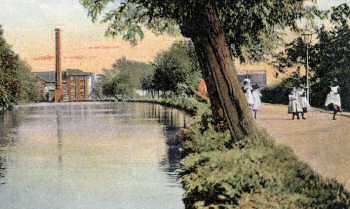 |
|
Mill
dam c.1904
|
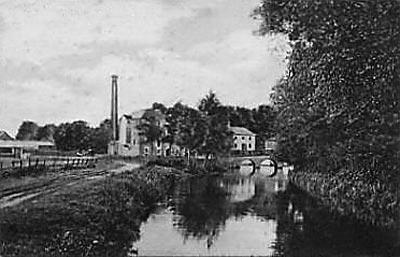 |
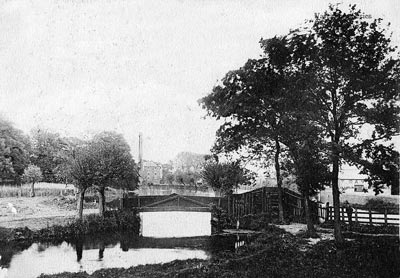 |
c.1904 |
Waterloo Bridge with the mill behind c.1904 |
1778: Matthew Budfdale and John Sainty for being concerned in the riot at Fakenham Mill, are to be imprifoned fix months. |
|
Early in the 20th century steam was being used to supplement water and a tall chimney was built on the end of the steam shed that could be seen for some considerable distance. |
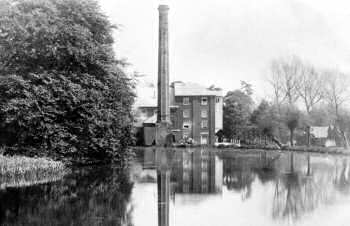 |
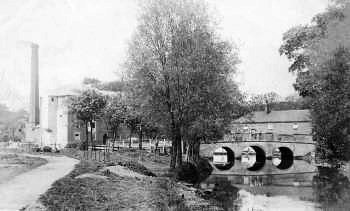 |
|
Chimney
and lucum c.1910
|
Smoking
chimney and the bridge c.1908 |
In the late 1800s, Charles Horsley ran Hempton towermill along with Fakenham and Sculthorpe watermills. Charles Horsley also had a granary at Wendling on the site of the towermill that had ceased working and been demolished a few years before.. |
Royal Exchange Fire Insurance policy 106897 |
Wm. Green of Fakenham in the County of Norfolk, Miller. On his Dwelling House, Water Corn Millhouse, Granaries & Warehouses adjoing. & Communicating, brick, Stone, timber & tiled, sit. at Fakenham aforesaid & On the Mills therein, together with the Running Tackle, & other parts of the Machinery belonging thereto - £500. Furniture therein - £50. Utensils & Trade in the same - £400. On his Stables, Waggon Houses adjoing. & Granarys Over, brick, Stone & tiled, near - £50. Utensils & Trade therein - £100. 16th June 1788 |
Horsley & Son, Millers and Merchants; |
The business controlled by Messrs. Horsley & Son, millers and merchants, is one of the most extensive and influential of its character in the county of Norfolk. It was founded many years ago, and has grown and prospered at a steady and substantial pace right from the start, a result which furnishes abundant testimony to the enterprise and ability displayed in its management. The mills are situated on the river side, a few minutes' walk from the Eastern and Midlands Station and Great Eastern Station, and are of a very extensive character. They are equipped in part with the best improved roller plant, the firm still retaining the advantages of the old-fashioned stones. The general arrangement of the mills is especially admirable and convenient, Messrs. Horsley having spared no expense to turn out the very best productions. They employ a large number of hands, and experience no difficulty in meeting all demands in the promptest style. The firm is also well known as general corn merchants, for the convenience of which business they utilise spacious granaries near the Great Eastern Station, besudes others at Wendling Station near Dereham. In leading commercial circles of the county Messrs. Horsley's name is held in high repute, and it can be safely predicted that so long as their business is conducted on the same able and enterprising lines as hitherto it will continue to prove prosperous and progressive. NIAS Norfolk Directory - 1890 |
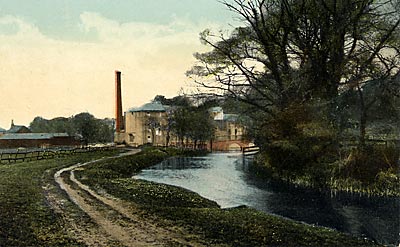 |
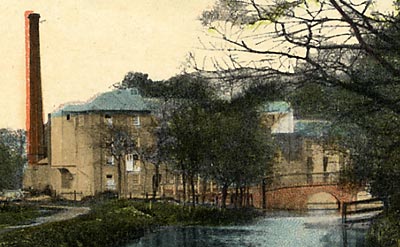 |
Postcard c.1913 |
c.1913 showing how colours were printed out of register |
When William Green died on 8th January 1841, he died intestate and letters of administration were prepared for his wife Pleasance. The Gentlemen bound and bounded to carry out this administration were Joseph Fyson and George Watson, both Gentlemen of Fakenham. Effects were shown as under £1600.0s.0d in the Consistorial court of Norwich. However in this administration of 1841 it states:- Genealogical data shows the reason for the reference to daughter and hence how the watermill owned by William Green came into the Fyson family. William Green had married Pleasance Case in Fakenham on 23rd June 1801 and he owned both the Heath postmill in Fakenham and the watermill. A Pleasance Green (daughter) had married an Edmond Heagren Gibbs in Fakenham on 4th September 1820 and then a Pleasance Heagren Gibbs married Joseph Fyson on 20th June 1837. It is understood that the daughter of William & Pleasance Green had married one Edmond Heagren Gibbs and subsequently as a widow, had married Joseph Fyson. Hence, Pleasance Green had passed on her daughter's inheritance when the administration was done on her husband's death in 1841. And Pleasance Fyson née Gibbs, formerly Green had signed in her own married name on the letters of Administration. The mill was actually owned by her and not her husband. |
William Green was almost certainly a relation of John Green who was running Hempton postmill. |
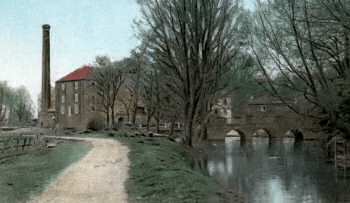 |
|
After
the gable end lucum was removed c.1915
|
By an inquisition, in the 38th of Edward III., it was found that they were not obliged to repair the causeway called the Brig-mill-dam, then broken down. In the 17th of James I., Fakenham-mill, and a parcel of land called Hulmore, with a warren, &c., were granted to Edmund Ferrers and Fras. Philips, subject to the annual rent of £5. 10s. This extensive corn-mill, which has lately been rebuilt, is now the property of Mr. Joseph Foyson, and is situated below the town, on the River Wensum, which is crossed by a handsome bridge of three arches, built in 1883, of white brick, with stone parapets and iron palisades. |
|
The 3 arch bridge of white brick with stone parapets and iron palisades was built by pauper labour in 1833. |
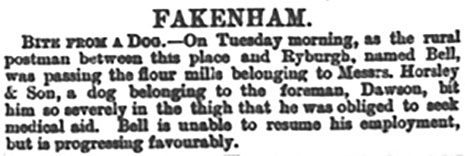 |
|
Norfolk News - 6th July 1889 |
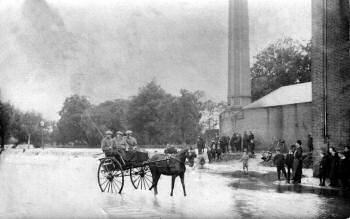 |
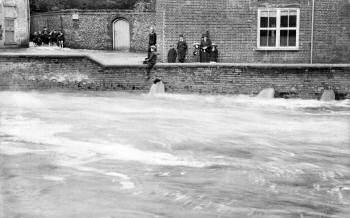 |
|
River
overflowing its bank 27th August 1912
|
Water
flooding around the mill 27th August 1912 |
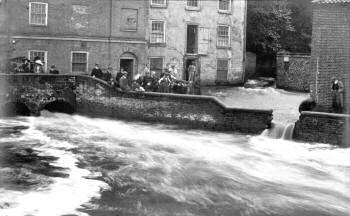 |
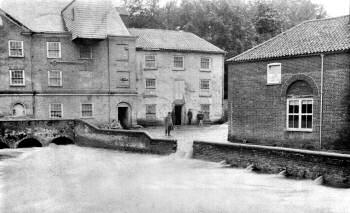 |
|
Section
of wall demolished to help the flow coming around the mill 27th August
1912
|
River
level has almost reached the height of the water coming around the mill
27th August 1912 |
|
Fakenham Mill was about one mile downstream from Hempton Mill, which in turn was about two miles downstream from Sculthorpe Mill This meant that except in times of maximum river flow, the three mills would have had to have been worked in conjunction. When Sculthorpe opened its wheel sluice and started to use its stored head of water, the outflow would head towards Hempton's dam, ready for use before being passed downstream to Fakenham. In order to maximise the efficient use of the available water supply the millers at each of the mills used a system of smoke signals to warn their colleagues whenever the sluices were operated. |
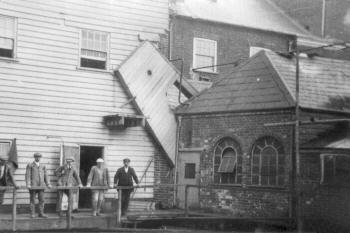 |
|
Staff
outside the mill in 1918
|
|
The wooden guarding covering the belt drive from the steam engine can clearly be seen |
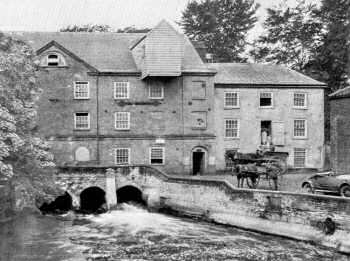 |
|
Tailrace in 1920 |
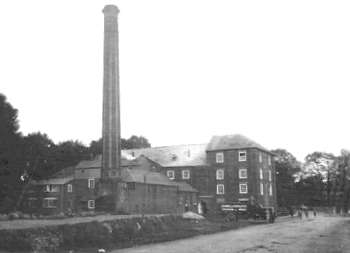 |
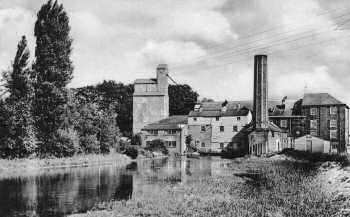 |
|
The
steam shed and the gable end lucum gone in 1920
|
The
truncated chimney stack c.1950 |
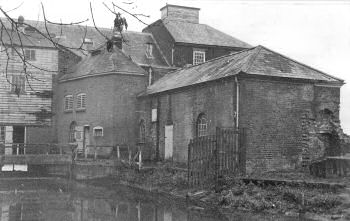 |
|
Base
of chimney bottom right 14th December 1975 |
|
During the 1960s Dewing & Kersley were cleaning wheat for Vitawheat as well as producing animal feed. |
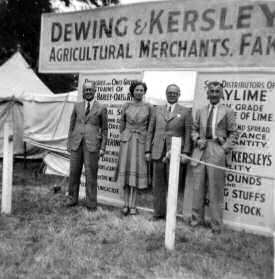 |
|
Dewing
& Kersley's stand at the
Royal Norfolk Show in 1949 |
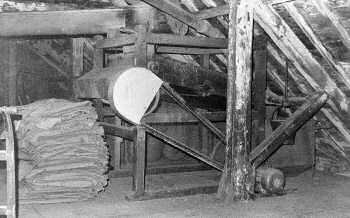 |
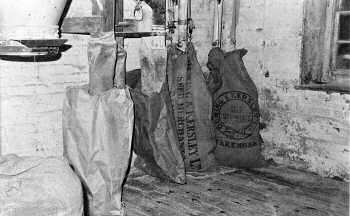 |
|
Shaker
unit 14th December 1975
|
Chutes
& sacks 14th December 1975 |
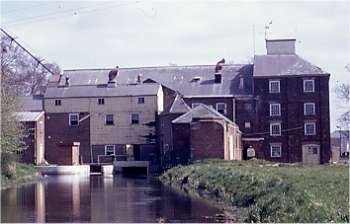 |
|
April
1967
|
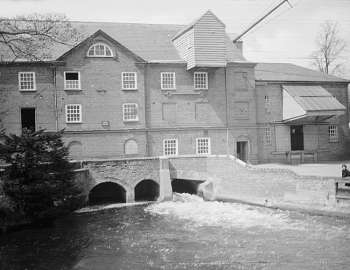 |
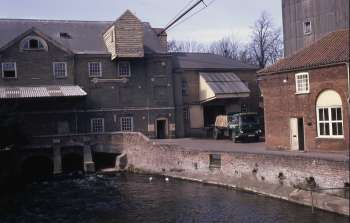 |
|
1951
|
April
1967 |
|
NORFOLK MILLS FACE CLOSURE |
Two mills of Dewing & Kersley are facing closure at Wells and Fakenham. This will be the outcome of the coming retirements of the two joint managing directors, Mr. L. E. Eagling, at Fakenham, and Mr. F. L. Cuthbert at Wells. Yesterday a reporter was told by Mr. Eagling at the Fakenham head office, "Wells is absolutely certain to go, and nothing short of a miracle could change the closure decision at Fakenham." A phasing-down process has been set in motion so the firm closes down by the end of the year. Redundancies will total 30, ten at Fakenham and 20 at Wells. |
EFFORTS |
Mr. Eagling, who began his career with the firm in August, 1926, as office boy, added every effort had been made to find a buyer, or buyers, "but we were unsuccessful." Mr. Cuthbert has been in the flour milling trade for 50 years, most of the time with Dewing & Kersley. The firm is completely independent, with Wells as a flour mill, and the Fakenham mill producing animal feed stuffs. There are six lorries in use, three at each place. The Fakenham mill has been using all locally-produced cereals such as oats, barley, wheat and maize from other sources. Eighty percent of the Wells mill trade has been concerned with producing flour for the biscuit trade and the remainder for bread. The bulk of the wheat has been home grown but there is also a percentage from Canada. The port of Wells is in no way affected by the Wells closure. "A lot of our troubleis our geographical position. Four fifths of our flour goes to London from Wells and London is 120 miles from Wells," said Mr. Eagling. This alone put the North Norfolk firm at a disadvantage. Dewing & Kersley had been competing against Essex mills. "We can't give a firm date. It will take some time to run down but we have to cease milling by December 31st at Wells and obviously you couldn't run this place at Fakenham without that at Wells," he said. |
ALLOTMENTS |
Dewing & Kersley are also owners of allotments near the Fakenham mill and these are let mostly to staff. Both mills are landmarks in their localities. Straddling the River Wensum at Fakenham, the Dewing & Kersley mill is a focal point of one of the town's most noted beauty spots, which with the bridge over the Wensum, attracts many photographers, artists and anglers. The company was registered at Fakenham in 1909 but its history as a mill goes back much earlier. Augustine Canons of Hempton Priory founded during the reign of Henry I may have had a mill at Fakenham. Deeds of the existing mill date back to about 1760 when there was a water mill. Until the early years of the present century stone-ground flour was made at the mill which was in the occupation in turn of Mr. Joseph Fyson and Charles Horsley & Son., before it passed into the ownership of Dewing & Kersley in 1909. Closely identified with the developmet of the business was the late Col. Sidney Dewing, who was the chairman of the directors. |
CONCERN |
The Wells_mill was built in 1898. Before the war the firm was associated with a considerable export trade. |
|
Mill sold for £50,000 |
Two businessmen have bought the old corn mill in Bridge
Street, Fakenham, which has planning permission for conversion into a restaurant
and nine flats. The sale was conducted by the Norwich office of estate agents Watsons on behalf of Picken Poultry Producers. Mr. Alan Cole, partner at Watsons, would reveal only that two local businessmen had bought the mill for about £50,000. He added the businessmen had not said what their intentions were for the property. Eastern Daily Press - 21st September 1982 |
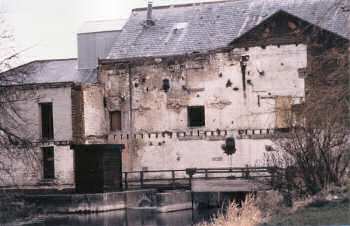 |
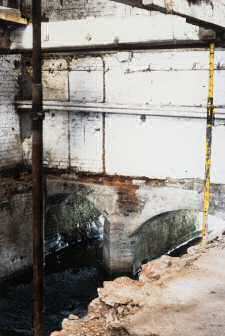 |
|
Weatherboard
section demolished c.1983
|
Internal
water channels c.1983 |
When I was a child at Fakenham, we would often walk down to the river via a road flanked with poplar trees, locally known (then) as the 'Unter den Linden'. Before they altered the road, there used to be a bridge and a ford, as well as an extra stream with a footbridge, where we used to stand and catch tadpoles (though I never used to know what to do with the wretched things once I'd got them in the jar).
The river, the Wensum, was a pale shadow of its former self. One old great-uncle, who had lived in Fakenham all his life, once told me that pleasure craft used to go along the river as far as Gogg's Mill. Though where from, and how big, I have no idea (at the time I imagined something like the Golden Galleon!!).
Linda Steward - 1st September 2005 |
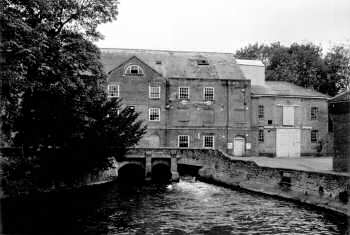 |
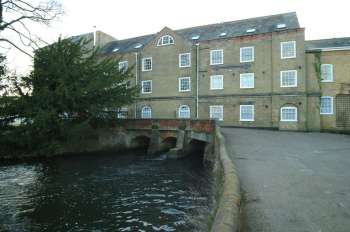 |
|
After
closure in 1981
|
After
conversion March 2003 |
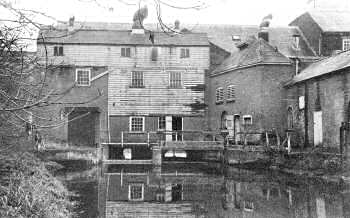 |
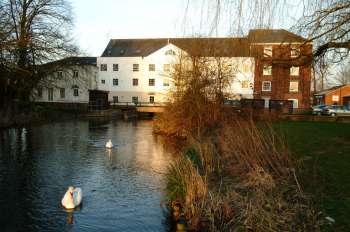 |
|
Mill
dam 14th December 1975
|
Mill
dam 9th March 2003 |
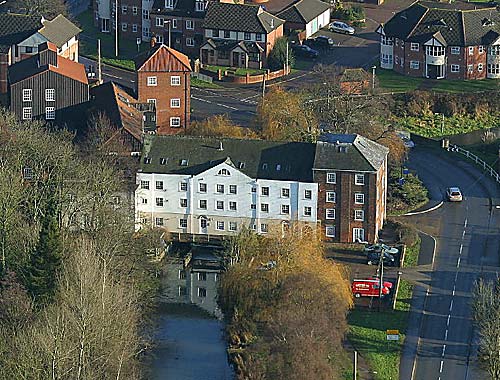 |
2nd January 2006 |
Mills |
|
6.16 The mill structures have a profound influence on the river system in the Wensum catchment. If high retained water levels continue upstream of the mills, they would form a significant constraint on the effectiveness of river restoration. Physical modifications at mill sites should aim to restore a more natural longitudinal profile to the river and to remove or reduce physical barriers to the movement of fish and wildlife. Whilst historically a number of mills have been in existence for centuries these have always very actively stored and released water and the cessation of working of the mills in combination with dredging has had a significant impact. 6.17 The recommended actions at mill structures are shown in Table 9. At a number of sites there is no mill building and removal of water level control structures would be the desired course of action. However, often there are multiple channels at a mill site and it is likely that some hydraulic controls would be needed to maintain a split of flows to all channels. These would probably take the form of a fixed crest and a natural chute that would allow the passage of fish and woody debris. At locations where the water level control structures are part of the historic mill building, there is often a variety of passageways and the best way to lower levels will need to be identified using more detailed survey. Initial action can be taken at low cost by merely adjusting operating levels using the available gates and stop boards. The reduction in head that could be achieved at a typical dry weather flow is also summarised in Table 9. The estimated maximum reduction in backwater length through changing the operational level of the sluices (that is, without the need for major engineering works) is 18km. This would reduce the length of the River Wensum SSSI affected by backwater from mills from 67% to 40%. To achieve this it would be necessary to ensure that no channels downstream of gates or fixed weirs are affected, but this could be a cost effective start to the Wensum restoration. 6.18 It is likely that at some locations, where the channel course has been altered and the mill channel is significantly higher than the natural channel, the main flow could be diverted upstream of the current mill location. Maintaining some flow to the original mill weir is likely to be preferable for aesthetic and heritage reasons, so by-passing is likely to be required in conjunction with lowering of the mill weir. Sites where such a solution is envisaged are at Great Ryburgh and Lyng. 6.19 The control structures at Costessey, Swanton Morley and Fakenham are used for flow gauging by the Environment Agency. Lowering these weirs may mean that the existing gauging arrangements will need to be replaced by other methods, such as ultrasonic techniques. The weir on the main channel at Swanton Morley has a two stage drop and a significant reduction in water level could be achieved there without affecting flow gauging through the bridge. 6.20 A former mill known as Gogg's Mill near to Fakenham was removed as part of the drainage improvement works of the 1950s. The channel upstream of the mill has narrowed significantly through the accretion of silt berms, and provides a good case study of the extent to which natural recovery can help restore natural river form and function. 6.21 As part of the River Wensum Water Level Management Plan being prepared by Entec (2007) the views of some private owners on changes in operating level have been canvassed. In broad terms this is not opposed, but there is concern to maintain an attractive setting incorporating some mill pond in line with the historical context particularly at: 1) Elsing 2) Great Ryburgh 3) Bintree 4) North Elmham 5) Lenwade. 6.22 A reduction in the retained water level at mills may constrain the ability to direct water through all the existing channels at mill sites, should this still be required, there may be a need to carry out physical modifications to some of the subsidiary water level control structures. River Wensum Restoration Strategy - Natural England, 26th June 2009 |
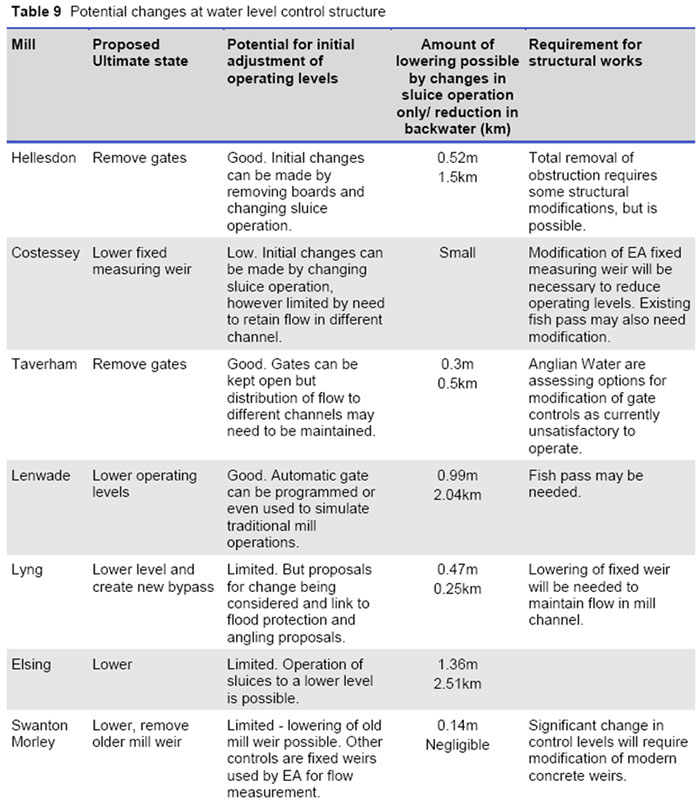
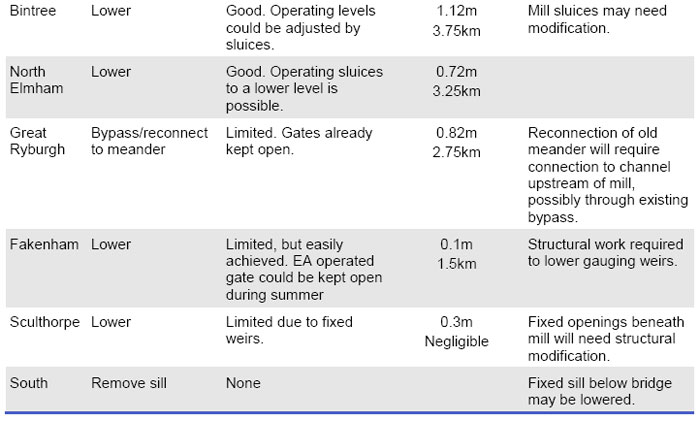
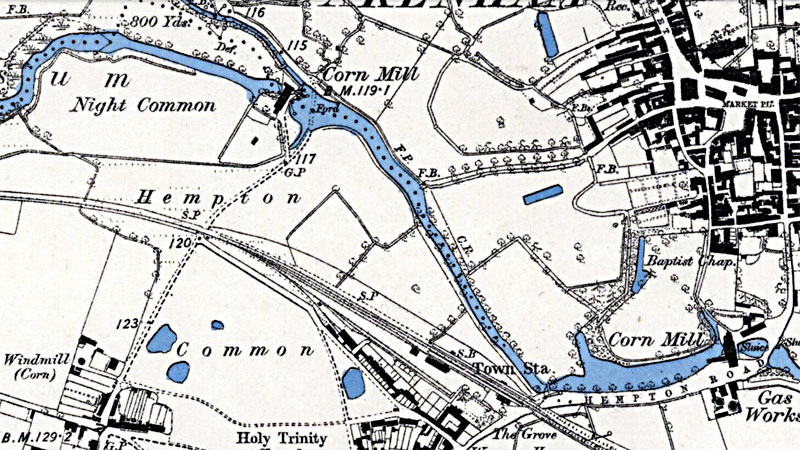 |
O. S. Map 1885 |
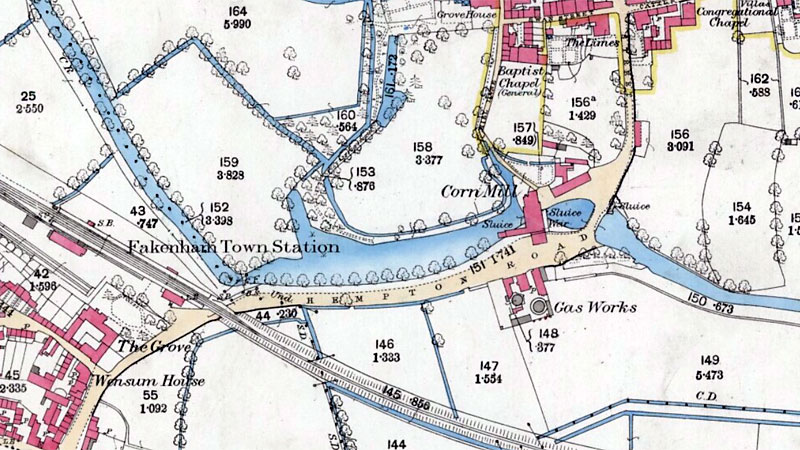 |
O. S. Map 1885 |
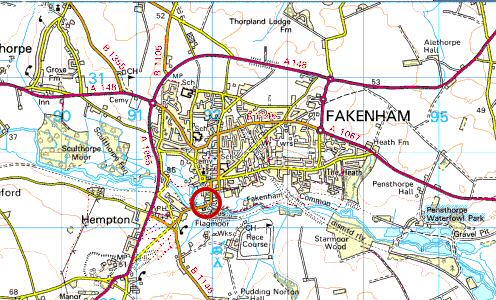 |
O.S. Map 2005 Image reproduced under licence from Ordnance Survey |
|
1620: Earlier
mill built and granted to Edmund Ferrers and Fras. Philips for annual
rent of £5.10s.
White's 1854: Joseph Foyson, corn miller Water Mill
Kelly's 1883: Charles Horsley & Son, also Hempton, Sculthorpe & Wendling
1909: Dewing & Kersley took ownership and registered the company at Fakenham
Kelly's 1937: Dewing & Kersley Ltd. |
If you have any memories, anecdotes or photos please let us know and we may be able to use them to update the site. By all means telephone 07836 675369 or
|
| Nat Grid Ref TF91932932 | Copyright © Jonathan Neville 2003 |